Government-wide hiring
Customer Experience
In April 2020, USDS and OPM initiated the Customer Experience Strategist (CX) Hiring Action Pilot using the SME-QA process. Nine federal agencies (13 components) participated and achieved the following results.
By the numbers
Participating Agencies
- Department of Agriculture
- Consumer Financial Protection Bureau (CFPB)
- Department of Education
- General Services Administration
- Department of Health and Human Services
- Internal Revenue Service
- National Archives and Records Administration
- National Aeronautics and Space Administration (NASA)
- Office of Personnel Management
- Department of State
- U.S. Patent and Trademark Office
- Department of Veterans Affairs
Customer Experience Strategist - GS-13/14/15 - 0301 series
Applicants
- 844 applicants applied in one day.
- 14,000 visits were made in April to the micro-site USDS built explaining this job.
Applicant backgrounds
The charts below collects the sector applicants belonged to when applying. Half of the pool of total applicants came from outside of government, including backgrounds in private companies, non-profits, and universities. The process did not favor applicants of a certain background.
Based on reviewing the resumes of all eligible applicants, 59% (171 applicants) did not come from a government background in their most recent role, 31% were federal employees at the time of applying, and 10% were federal contractors.
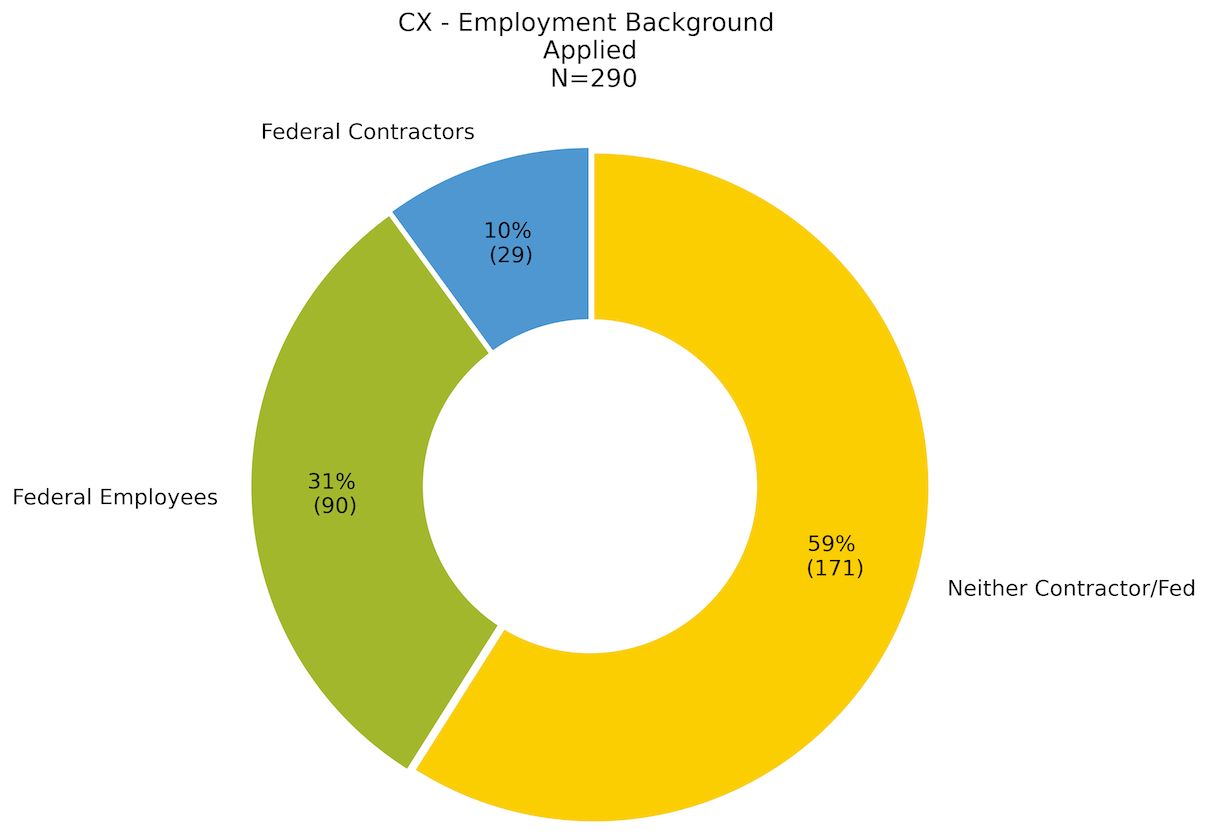
Applicants from all backgrounds were found qualified at similar proportions compared to those who were found eligible, as seen below. Although federal contractors tended to fare a little better than federal employees did over the SME-QA assessments, slight differences are expected and are normal.
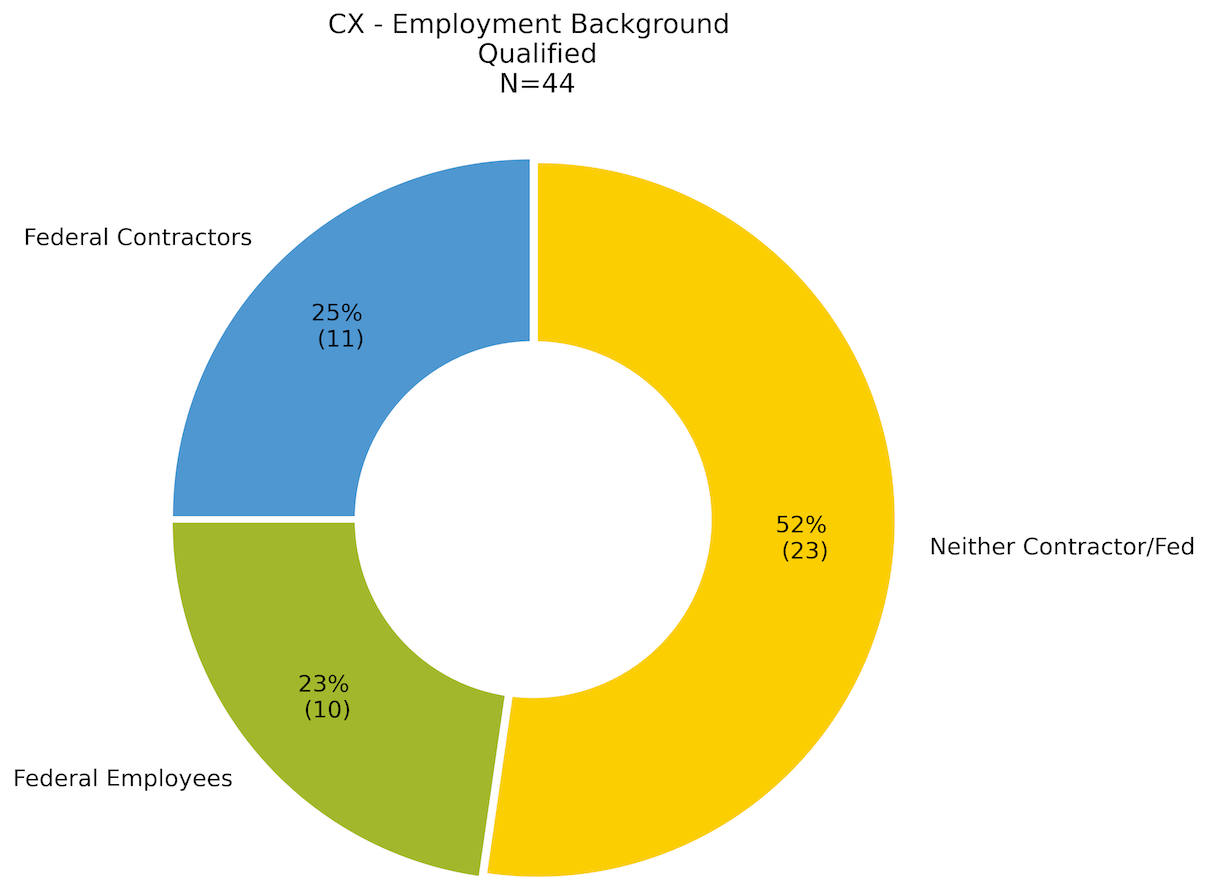
Finally, the distribution of background types remained consistent into the job offer stage.
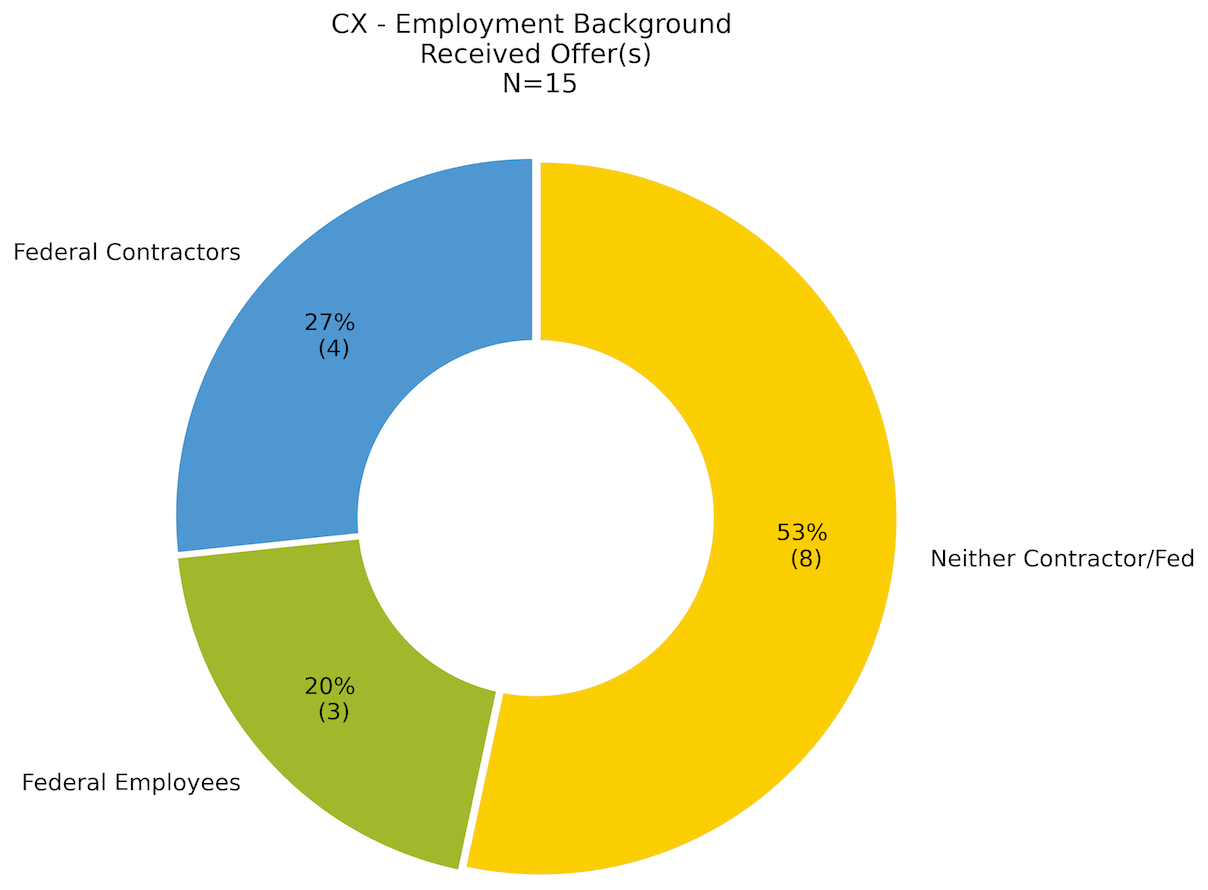
Subject matter experts
20 designers from eight agencies came together to evaluate applicants to the Customer Experience Strategist positions.
Assessments
- 291 (34.5%) applicants were eligible for resume review for submitting both a resume and a design portfolio.
- 124 (42.6%) of applicants passed resume/portfolio review.
- 79 (69.9% of the 113 applicants who attempted during this phase) passed the HireVue structured interview and were eligible for a second interview with a SME.
- 63 (81.8% of the 77 applicants who scheduled an interview) had qualifying scores after their second interview.
- Of the 63 applicants who passed the second round, 19 stated they would only accept a GS level higher than they qualified for in this process and therefore were not placed on any certificate.
- 44 applicants ended up on at least one certificate as shown below:
- 14 on GS-15 certs
- 27 on GS-14 certs
- 27 on GS-13 certs

Goals and outcomes
Goals
The goal of this pilot was to test the value of centralizing a hiring action using effective assessments where agencies can share SMEs and share the certificate to place the maximum number of qualified applicants throughout the government.
Outcomes
The CX government-wide action was largely successful, introducing 17 new experience strategists into government within 6 weeks from the posting of the job announcement to the creation of the certificate.

Our CX working group highly favored this process, with 92% of our SMEs expressing interest in repeating the process as a SME and 83% recommending this action to other government employees.
Participating agencies made a total of 17 selections and once they were done, additional certificates were shared with 3 agencies who were not part of the initial participating list. The initial agencies thought they had 30 openings at the start of the pilot, but by the end, due to positions and budgets shifting around because of COVID-19, there were 17 total positions to fill once certificates were issued.
New technology
Resume review tool
Our team worked with OPM to prototype a cloud based resume review tool to help HR receive SME input on applicant qualifications. SMEs batch downloaded the resumes and portfolios and then logged in to review each assigned resume against the pre-defined proficiency levels. The SMEs conducted resume review against all applicants at the GS13 level on a pass/fail basis. The tool automatically created queues for each SME and knew each resume needed two independent reviews. If the SMEs disagreed if the applicant passed, then the tool would automatically give the resume to a third SME to break the tie.
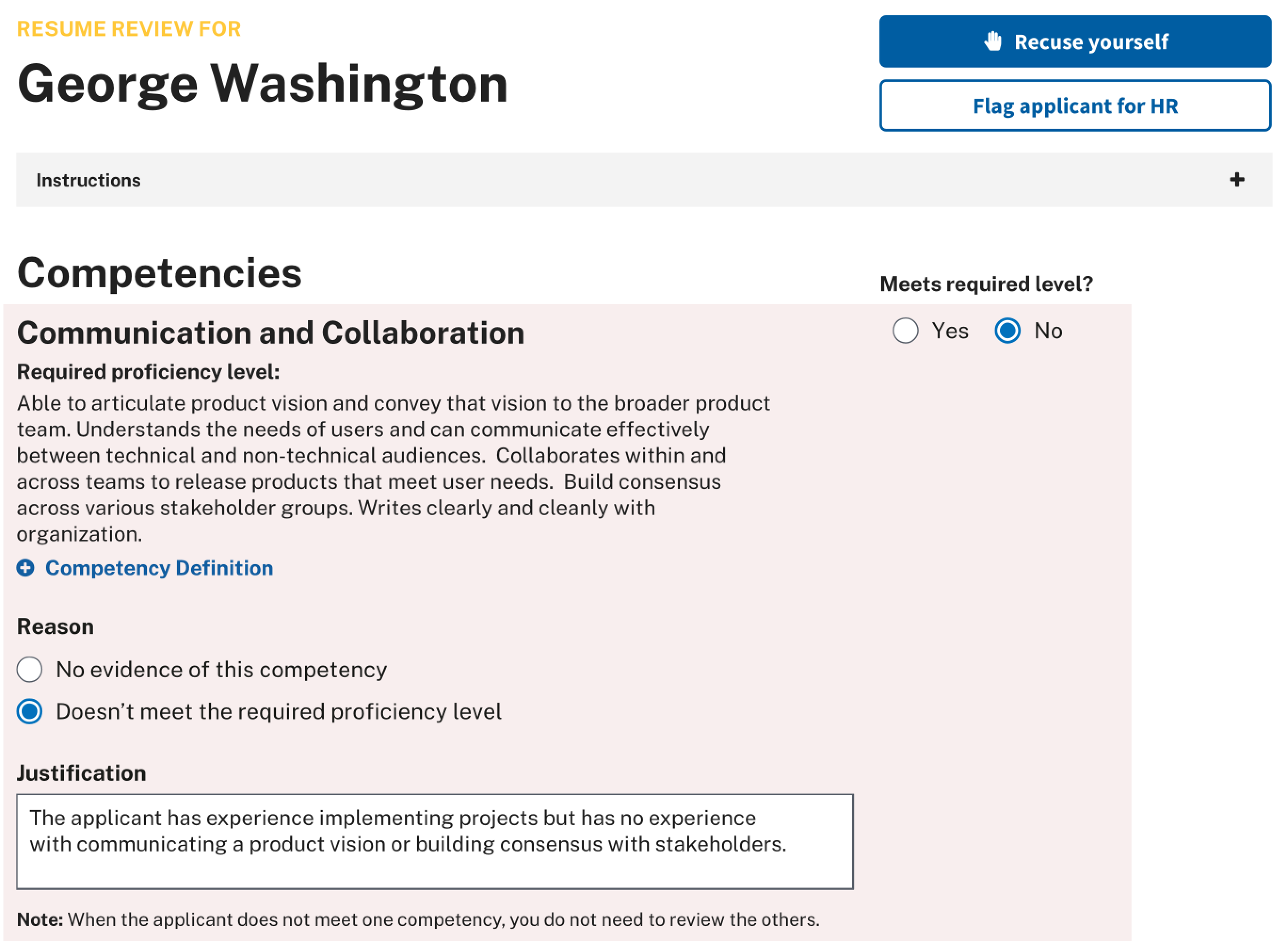
Screenshot of the SME view of the Resume Review Tool.
100% of the SMEs approved of the tool, indicating satisfaction on the functionality, ease, and design. The tool allowed SMEs to efficiently review the resume, analyze and evaluate an applicant against the competencies and proficiency levels, and review the applicant’s design portfolios alongside the resume, with the exception of resume and portfolio downloading, and competency definitions.
USA Staffing is now working with USDS to integrate this functionality into USA Staffing directly. Monster customers already have similar functionality in the Collaborate add-on.
The tool, I love it. It keeps it simple. No weird timing-out…There's an overall progress bar…I love US Web Design Standards, so happy to see that. The tool allows you to get in a really good rhythm.
— Subject Matter Expert for the CX hiring action
HireVue
Once applicants passed through resume review, they were invited to participate in two rounds of structured interviews. The first round was a 30-minute asynchronous breadth interview using the HireVue platform, an automatic transcription tool. In this instance, applicants attended a walk-through training on how to use the program, which could be accessed through any internet-connected device (phone, laptop, or tablet).
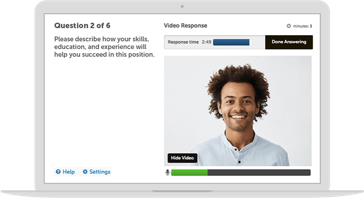
SMEs created videos of themselves asking each of the four questions which applicants could listen to when doing the recorded interviews. We turned off video and just had the audio on in case there were concerns about the government unnecessarily recording people's faces. Because we saved the audio link within the case file, the SMEs saved time not having to transcribe each interview as they did in the second structured phone interview.
The tools garnered positive feedback with 100% of our SMEs approving the tool to evaluate applicants, noting that the tools was simple to use, could go through the questions or go back and listen to other applicants, and replay responses to gather more detail. However, the downsides to the tool was not being able to follow up on questions, not able to reference resume or portfolio, and questioned the tool’s ability to be fair and unbiased. Regardless, SMEs would recommend the use of HireVue for a future hiring action while being aware of the risks and human limitations that could present itself during the interview such as not being able to follow up with candidates.
ScheduleOnce
The second interview was an hour-long phone interview with one applicant and one SME. In the second round, USDS acquired a scheduling tool, ScheduleOnce to eliminate as much scheduling burden as possible on the hiring manager, and overall, improve the experience. The project manager coordinated with the hiring manager to facilitate scheduling of interviews and worked with an engineer from ScheduleOnce to resolve any technical issues.
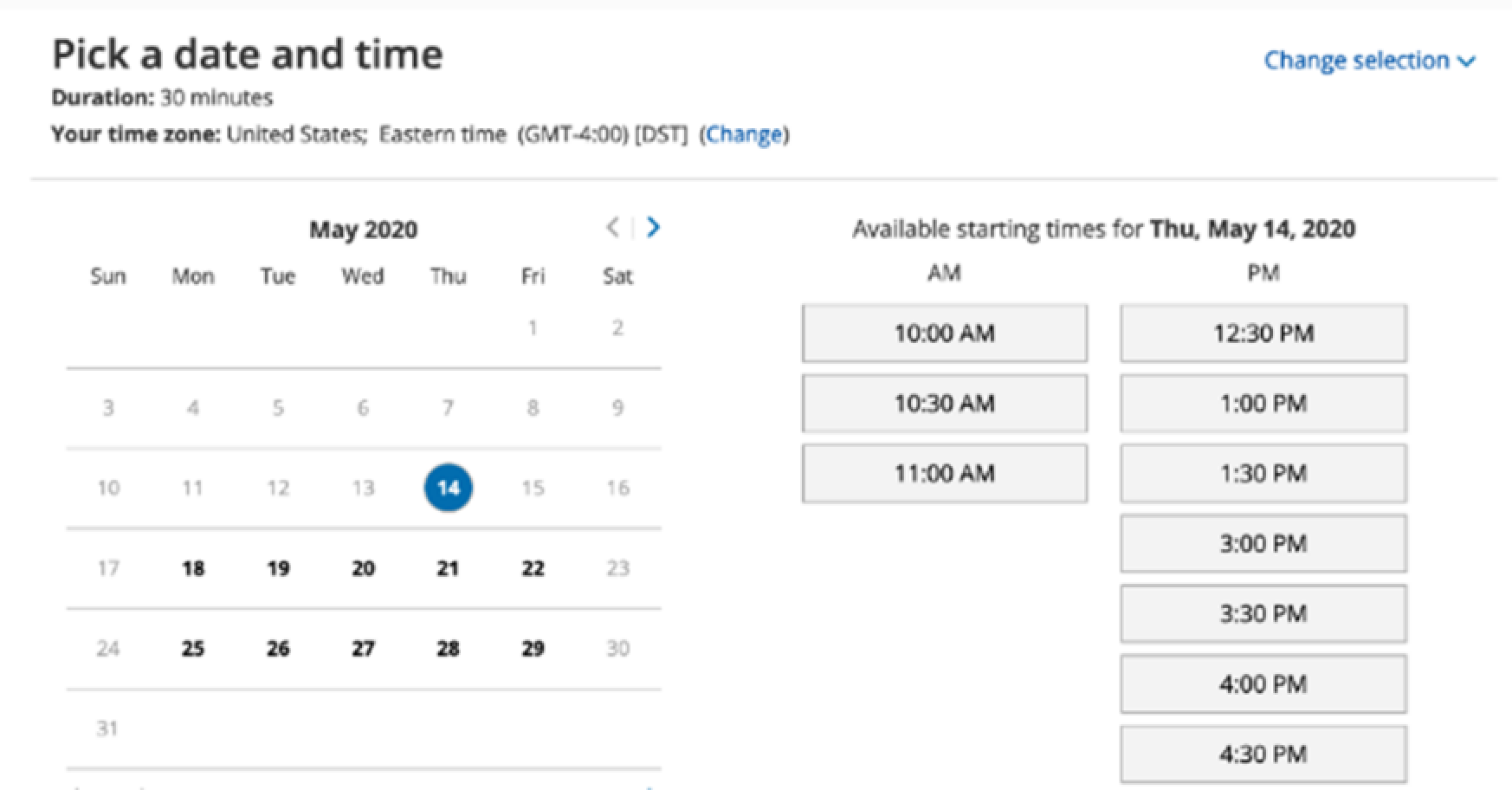
Lessons learned
Some of the most pressing challenges in this phase revolved around understanding the process of certifications and actually pushing them forward on the agency’s behalf.
Certificate sharing
For one, certificate sharing also occurred outside of the original participating agencies. There were agencies that heard about the certificates and wanted to make offers as well. Those agencies also needed to submit an SF-52, confirm that the competencies are the same for the job they are hiring and the job our team posted, submit a relevant PD, and go through the additional requirements. In this case, a concern was having agencies initiating a new hiring action and conducting a separate interview, while still having access to OPM certifications. Regardless, hiring managers were allowed to access the certificate and begin conducting interviews concurrently to the time-period when HR is going through these other steps.
Certification delays
Another flag was having agencies share their certifications at the end of the hiring action. OPM required that the agency HR specialist contact the OPM HR specialist to first complete and sign a “Request for Certificate of Eligibles” form (see attachment in Appendix). Agencies were struggling to turn this in, adding more burden and paperwork up front, which disempowered our hiring managers. As a result, some agencies delayed in issuing certifications by several weeks. Having a hiring manager with the name of the available applicant on a shared certification list can motivate the HR shop to quickly process all of the paperwork as it gives them a bit more autonomy in the process. It would be ideal to have USAJOBS add a default USAJOBS template notifying applicants that they will be shared with other agencies for immediate selection in the same series and grade.
Timing
Separately, agencies did not have enough time to select their candidate within the 10-day period. Several conversations between agencies stressed on requiring more time and communicated with OPM HR to decide how much time each agency should be given in order to select. Our recommendation in this case was to continue giving agencies a 10-day grace period with priority access. After the deadline passes, the certifications will be opened up to other agencies, noting that the original agency can apply for an extension, however, there will be other agencies now competing for selections.
Selection opt-out
In the end, some agencies did not issue selections because of varying circumstances. Some agencies deferred over budget concerns, while other agencies could not select due to the impact of COVID, and a hiring freeze, which stopped the paperwork from further processing even though the agency had given their verbal intent to hire the candidate.
